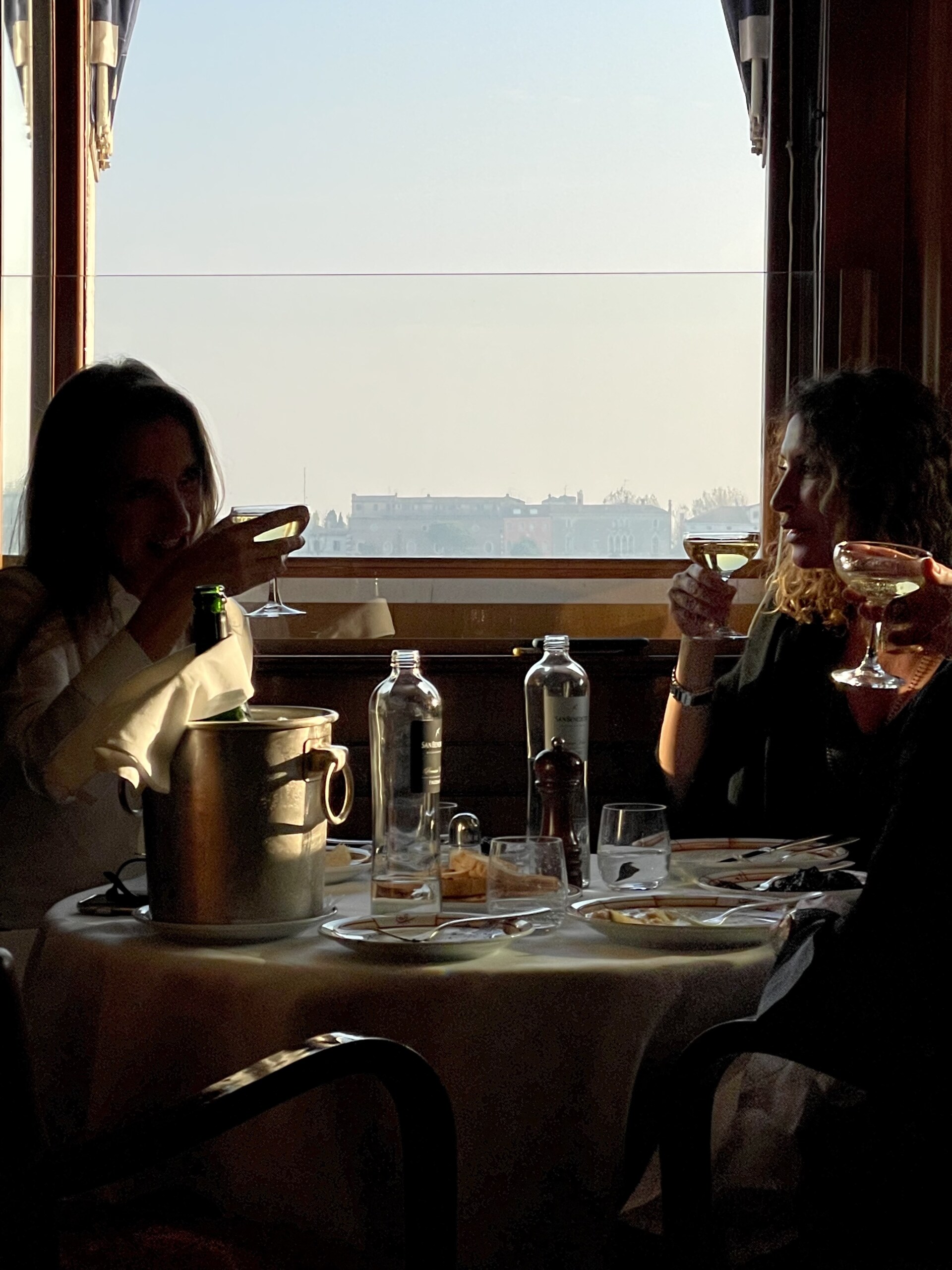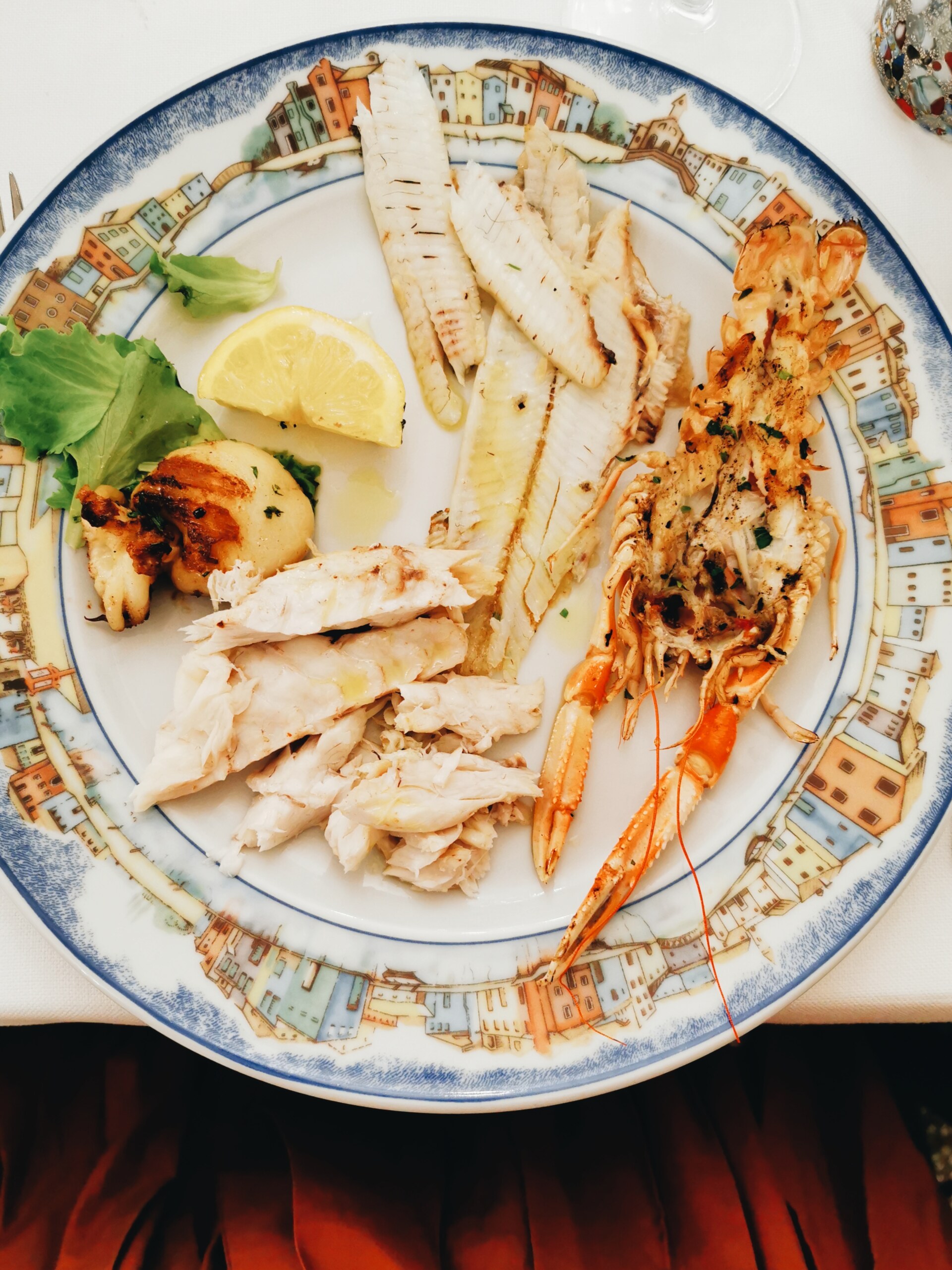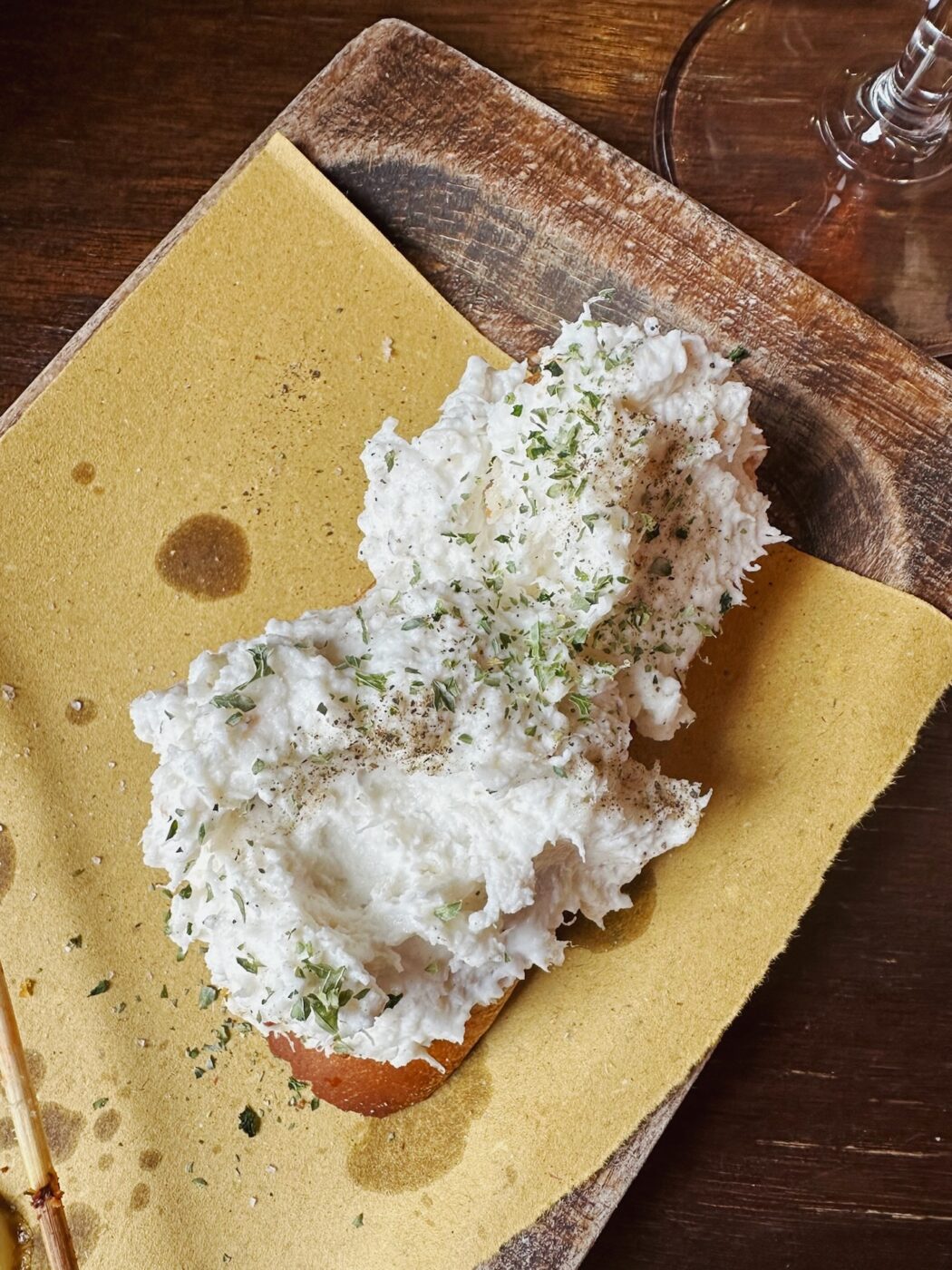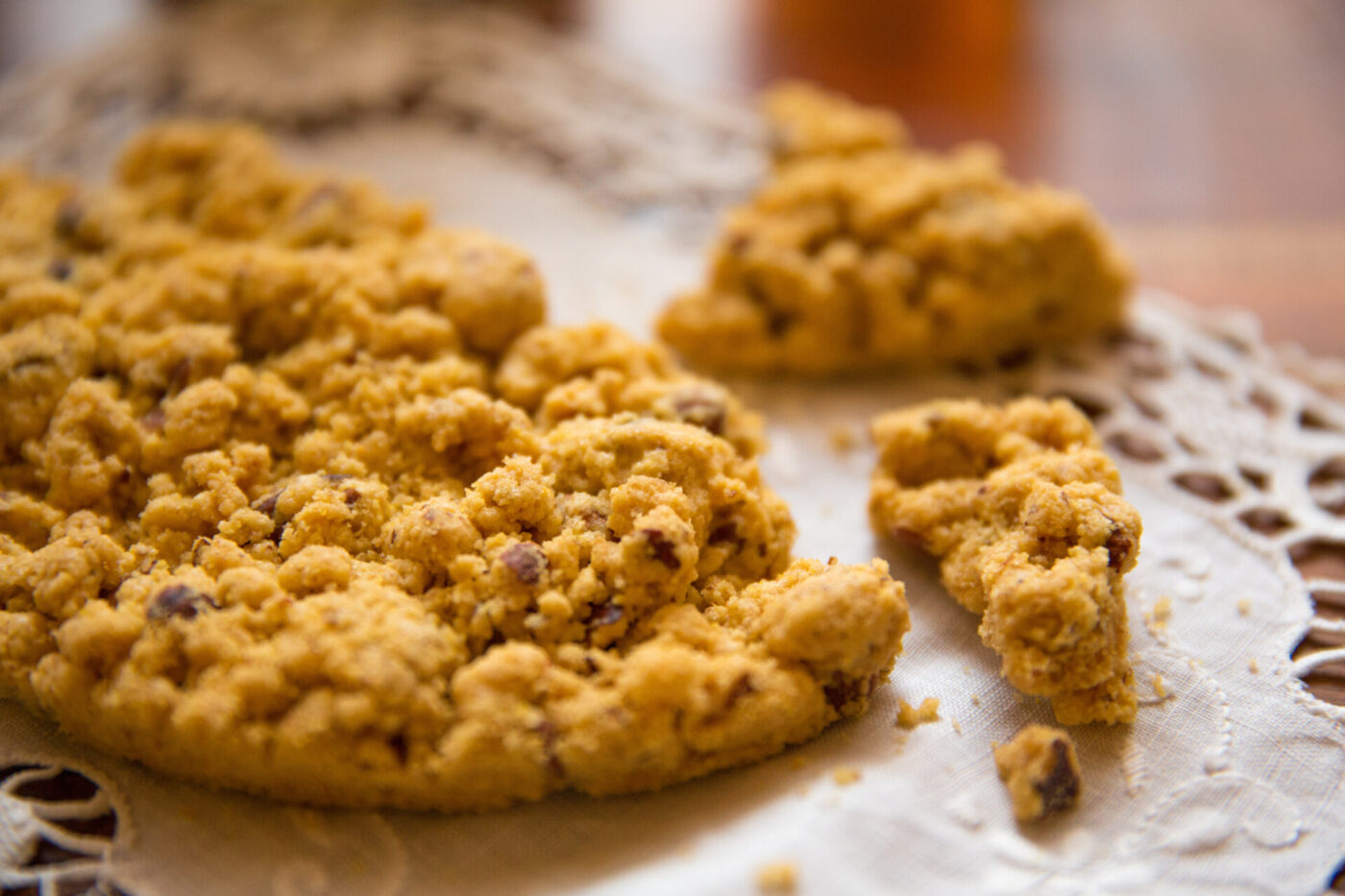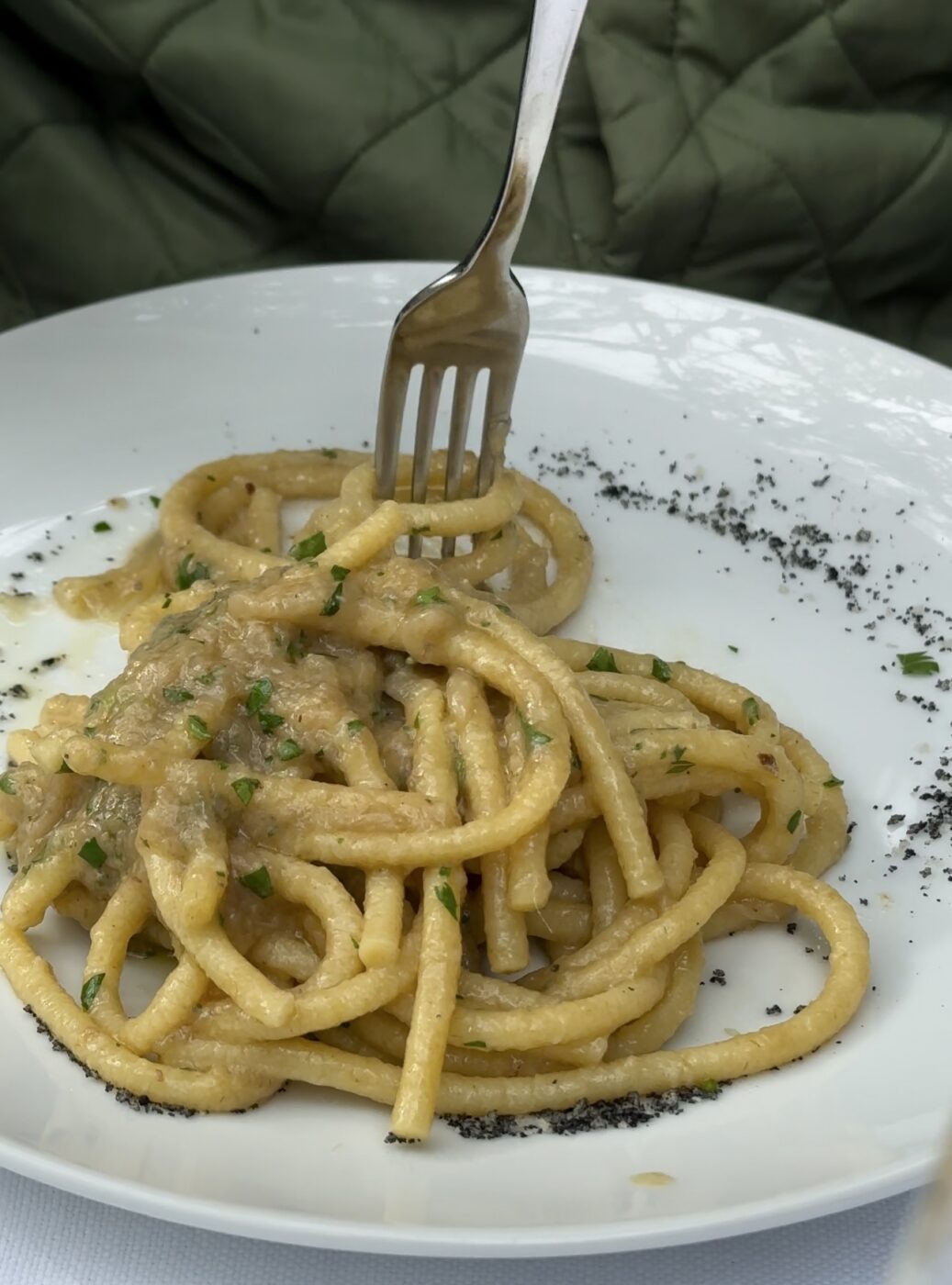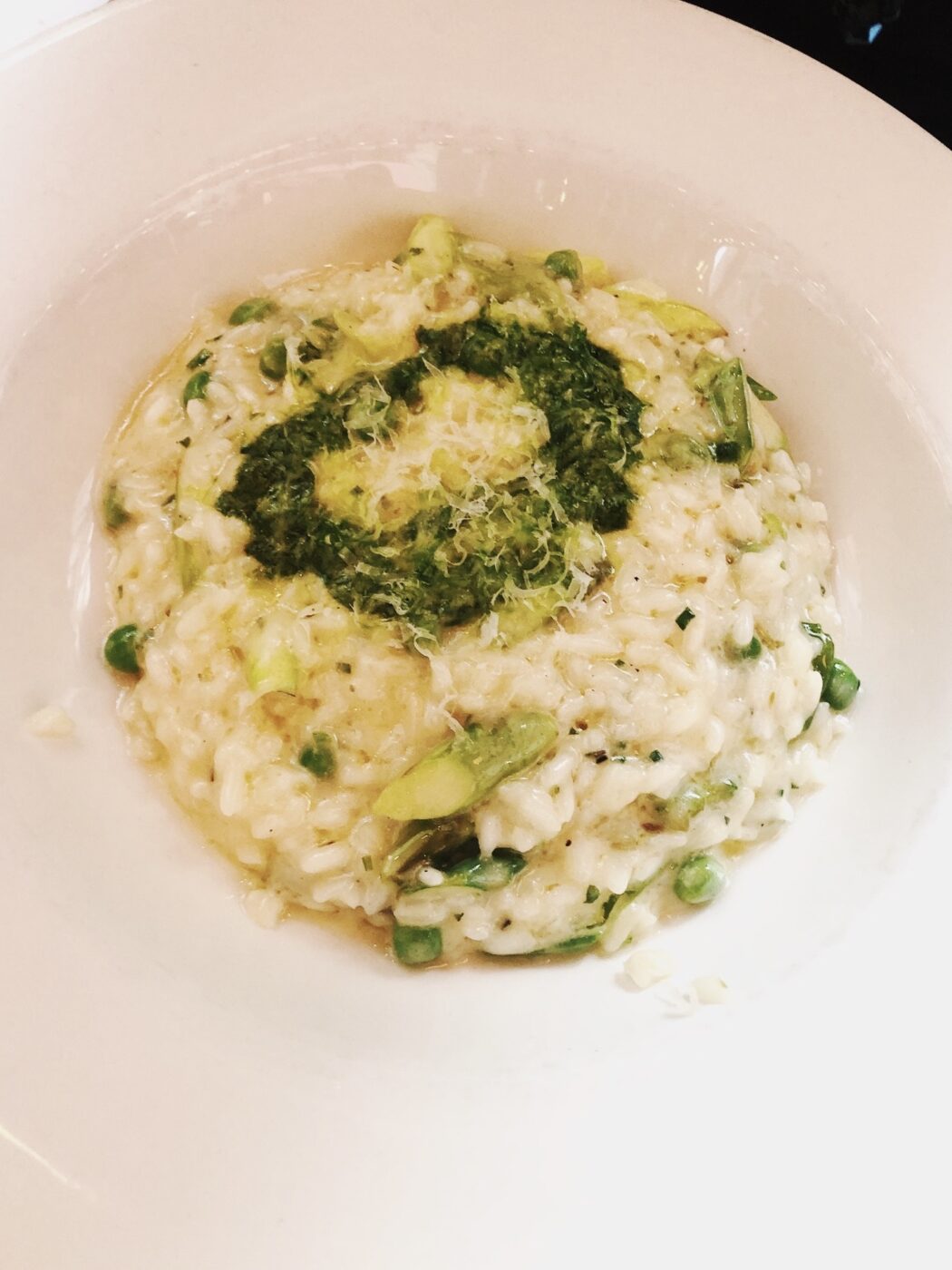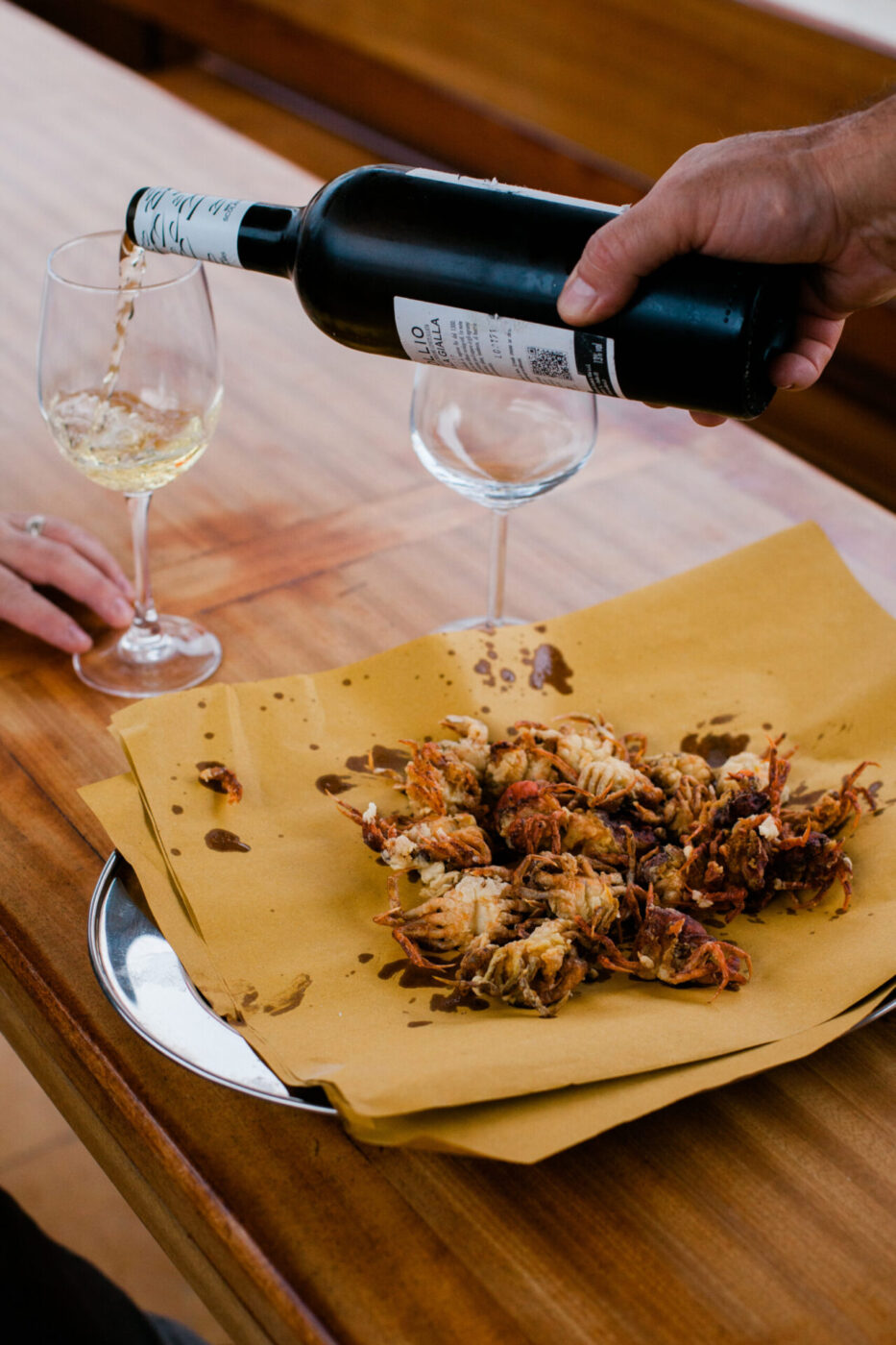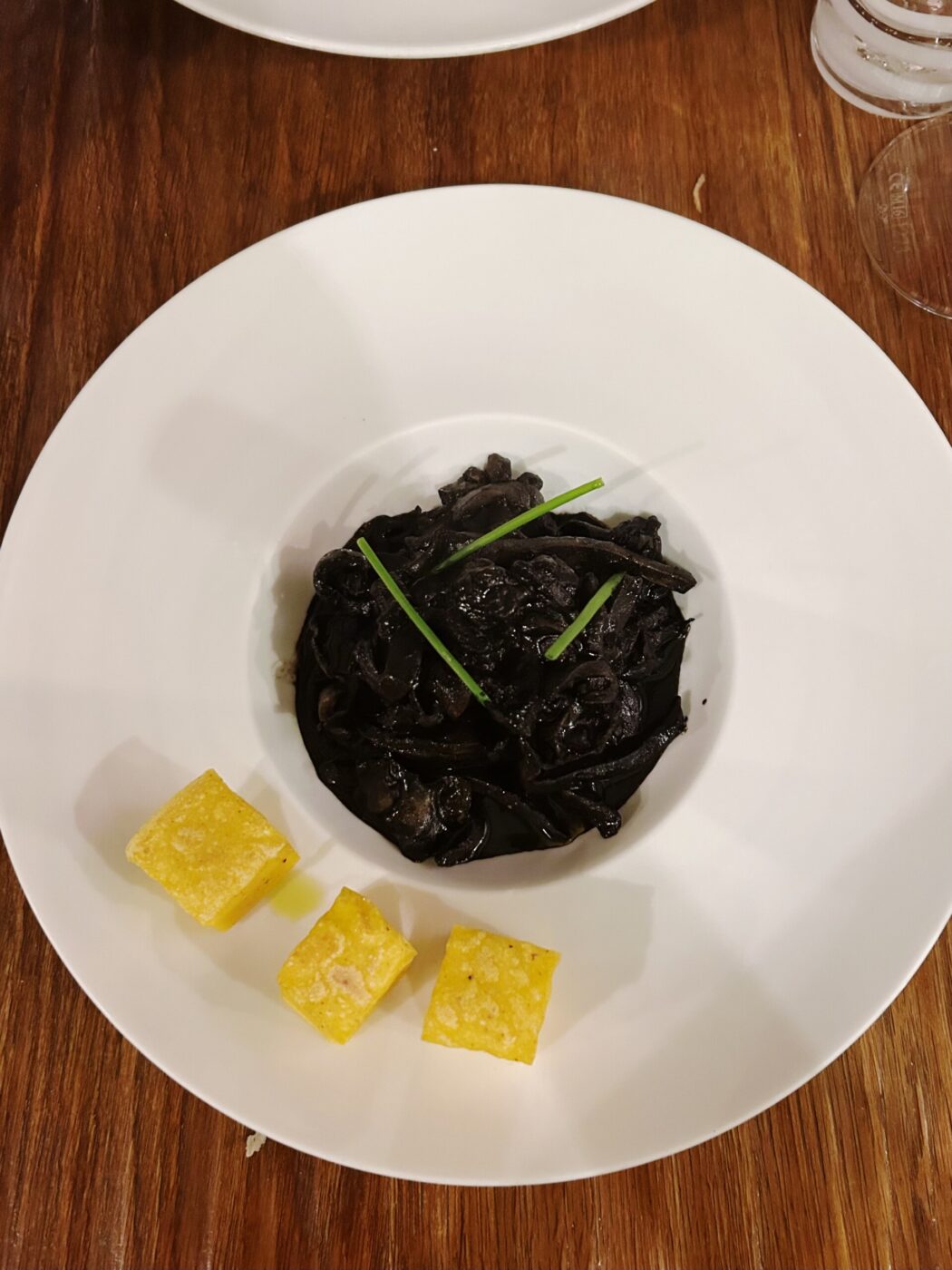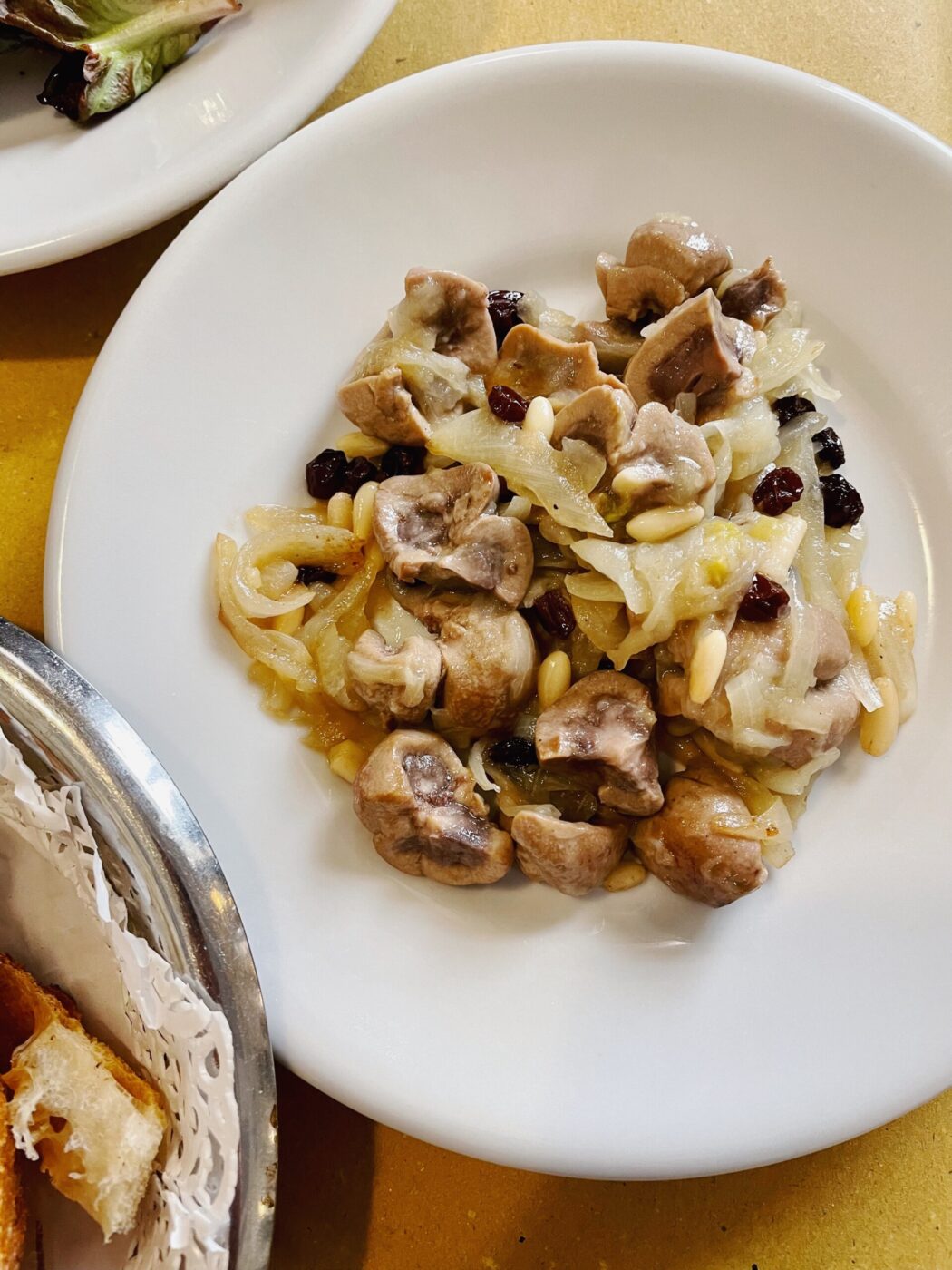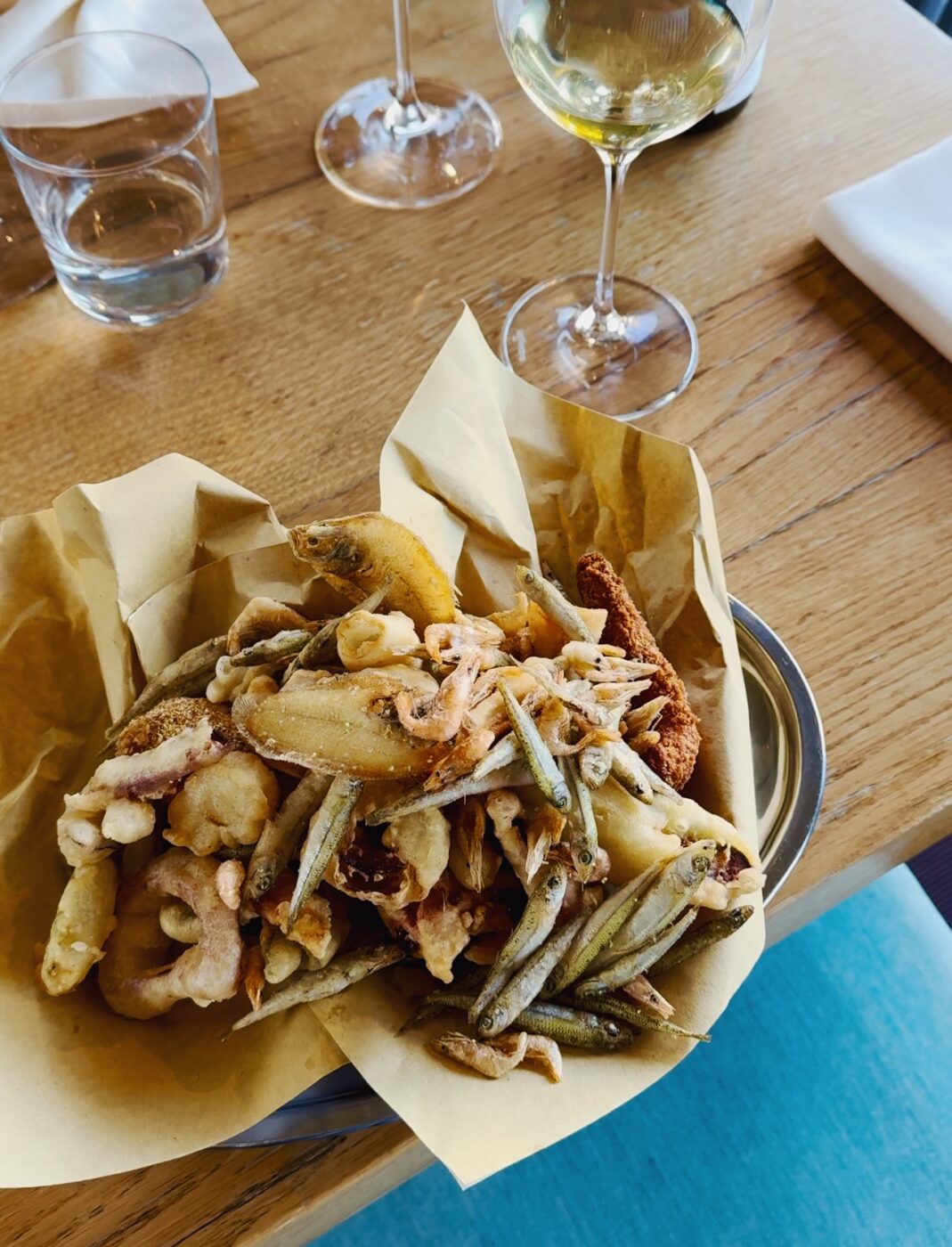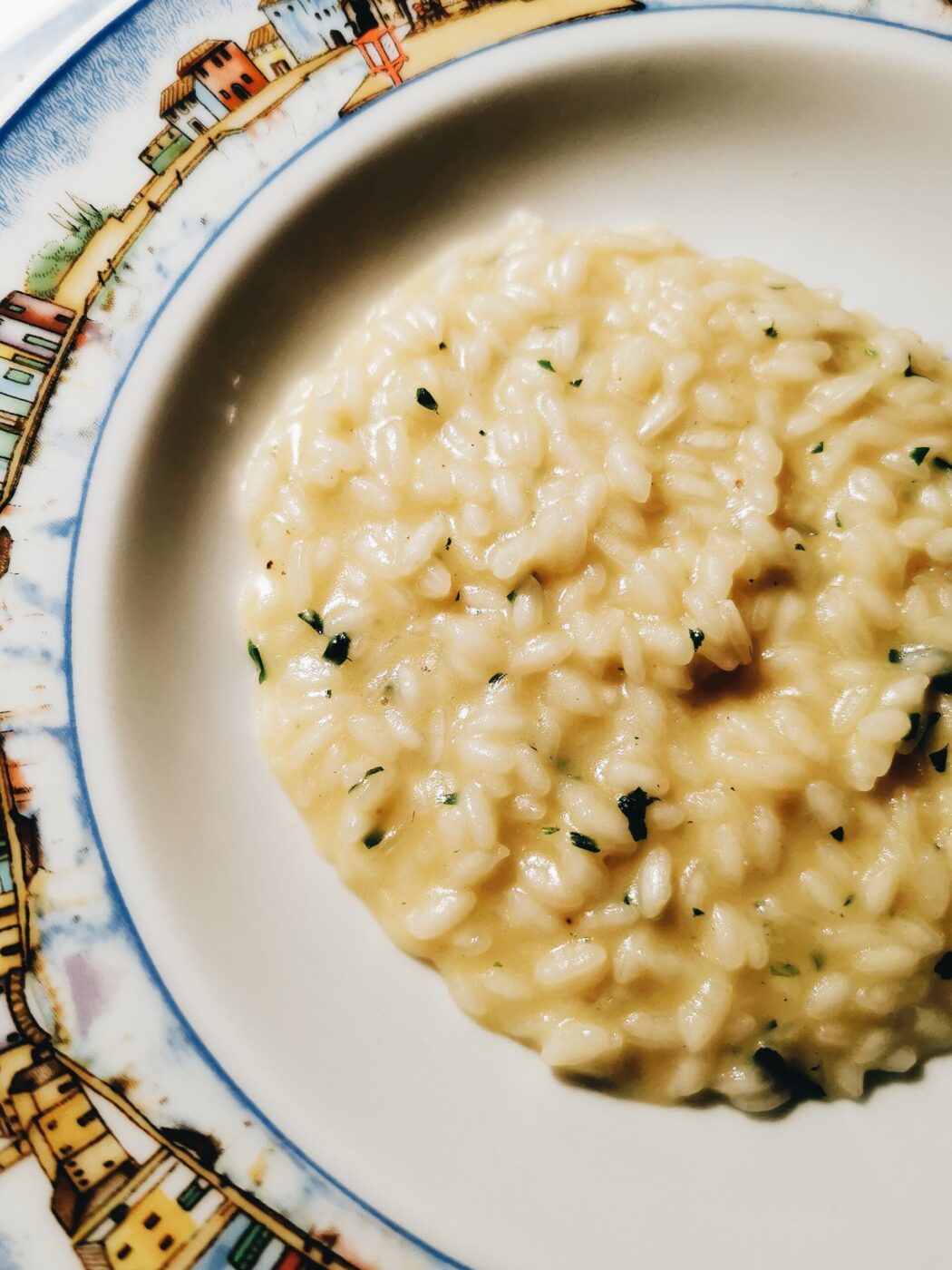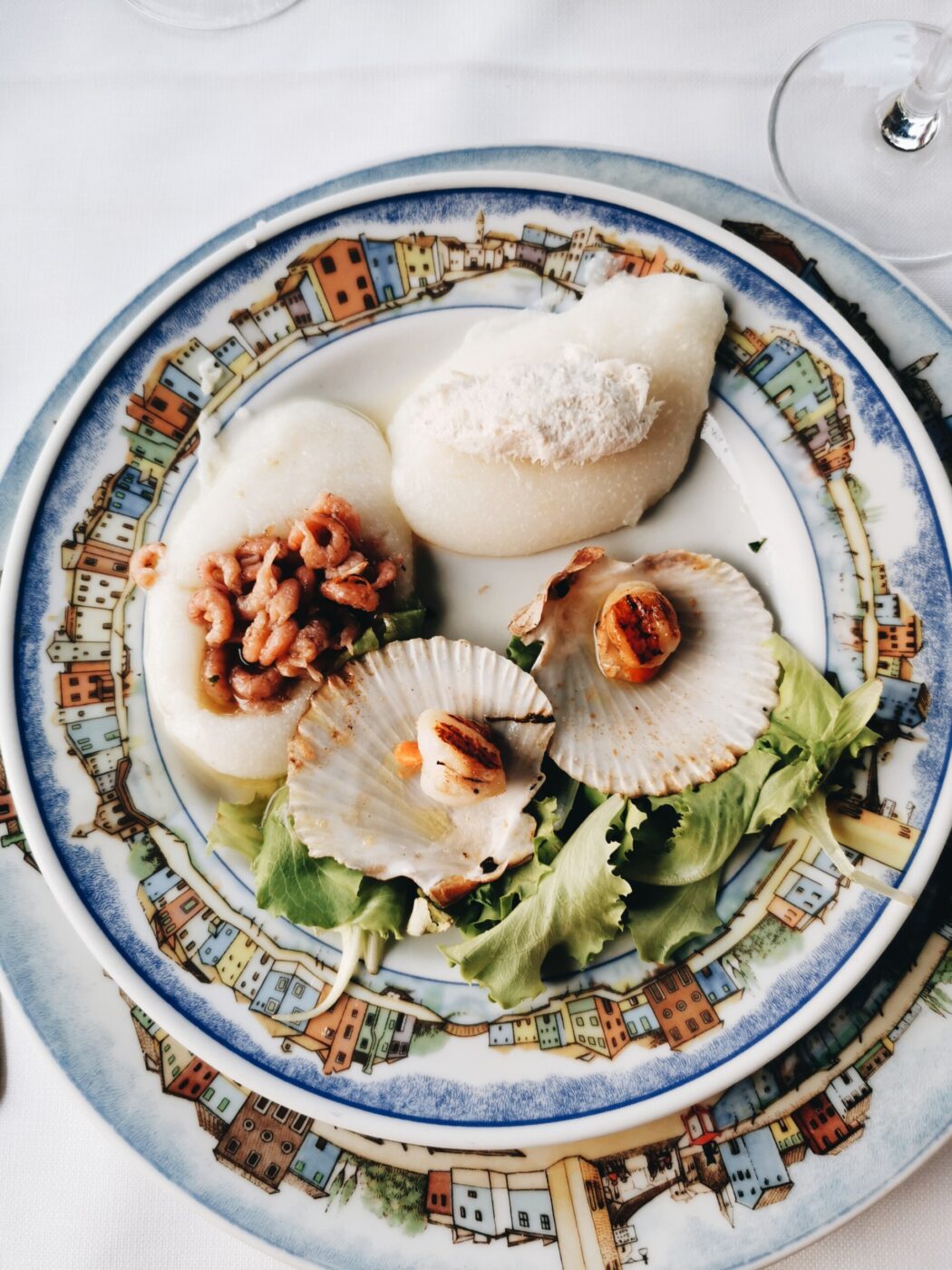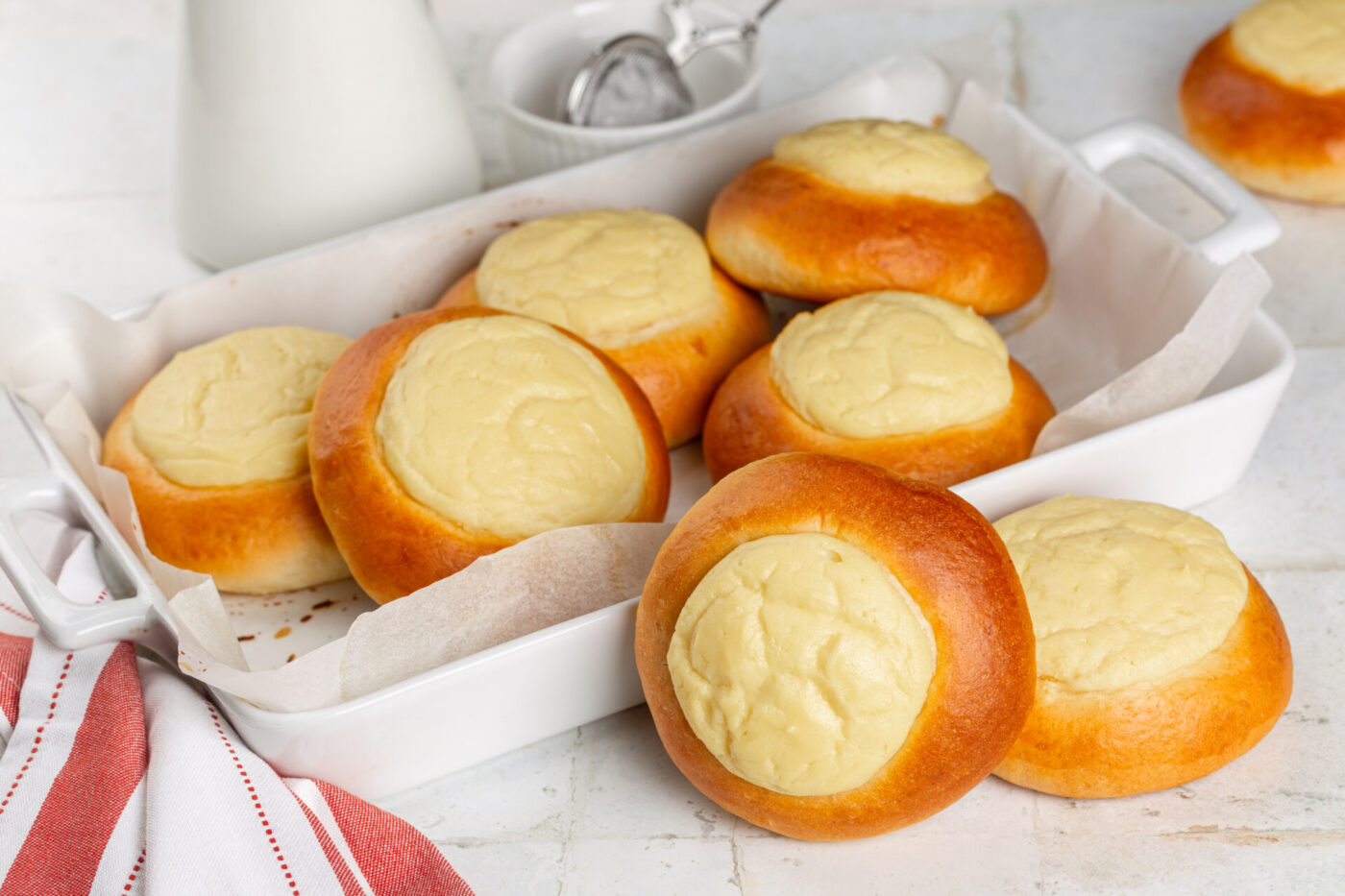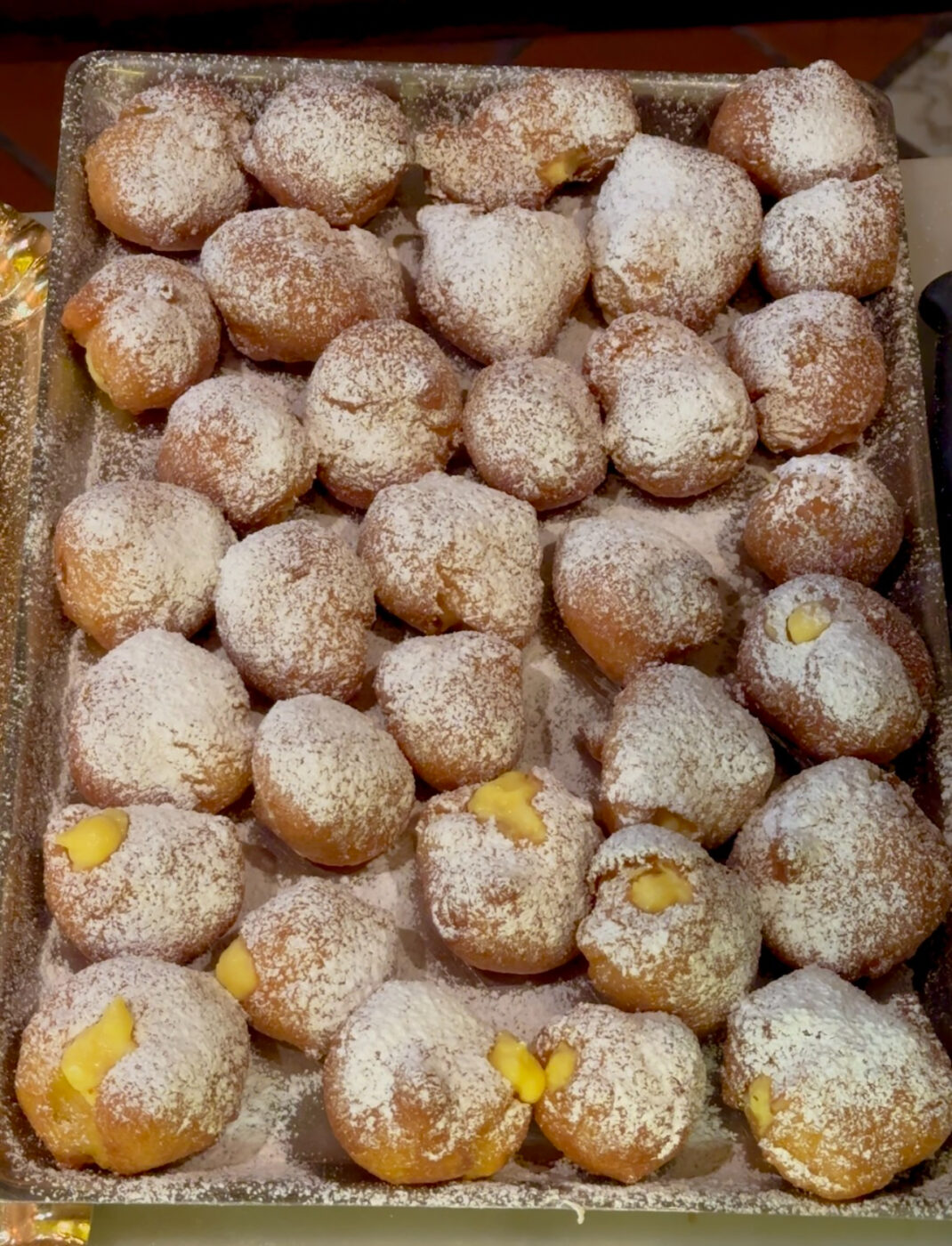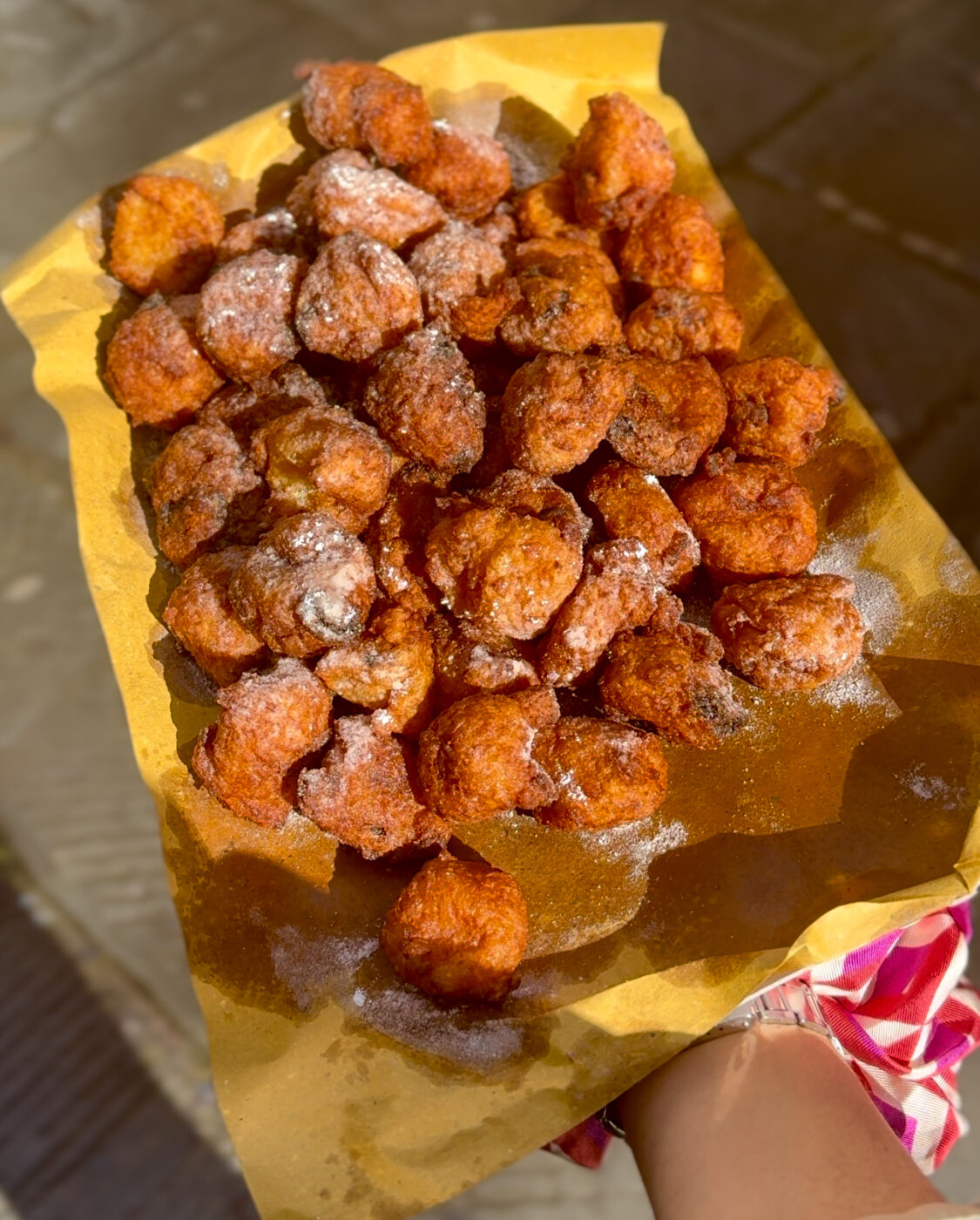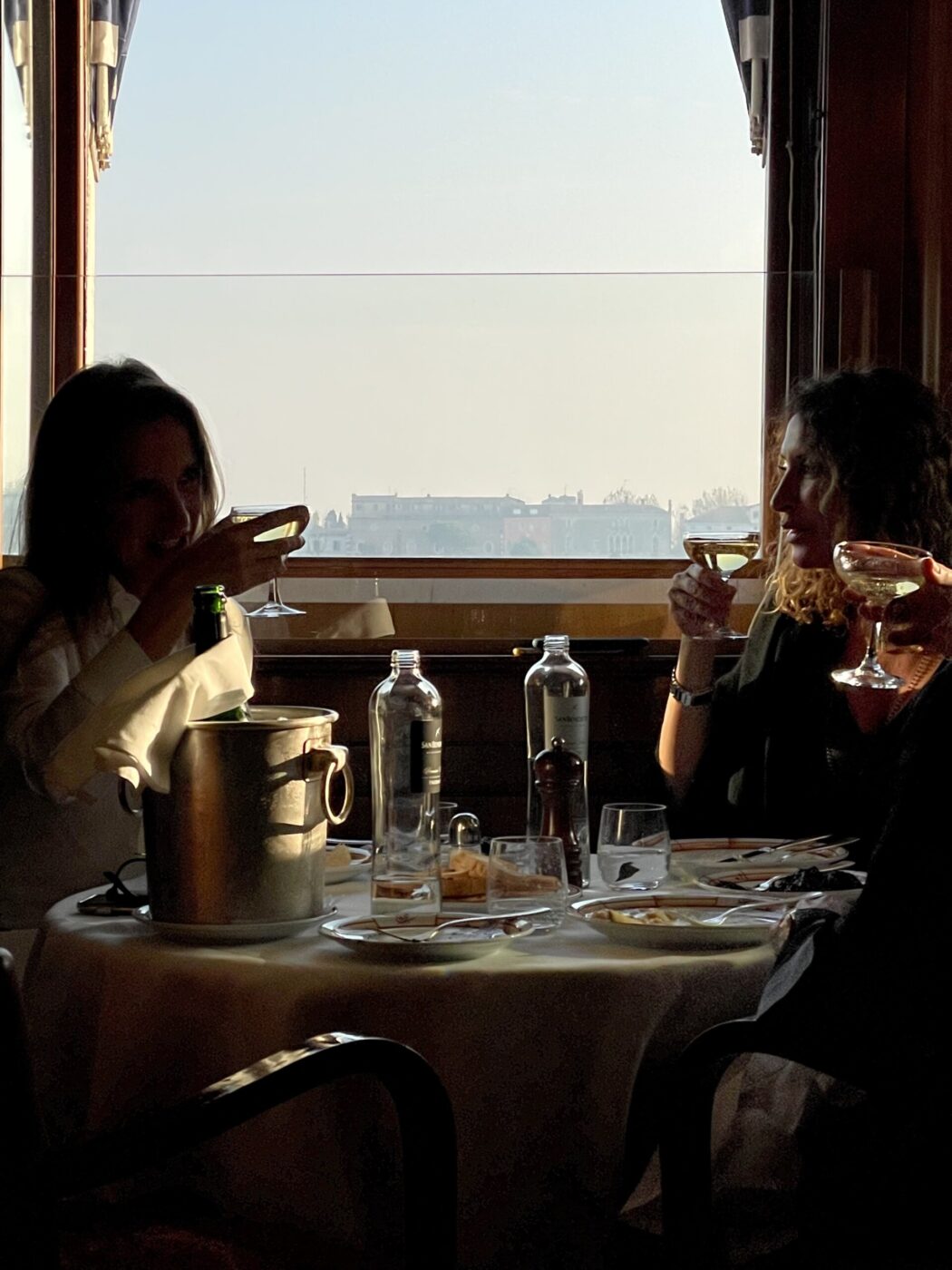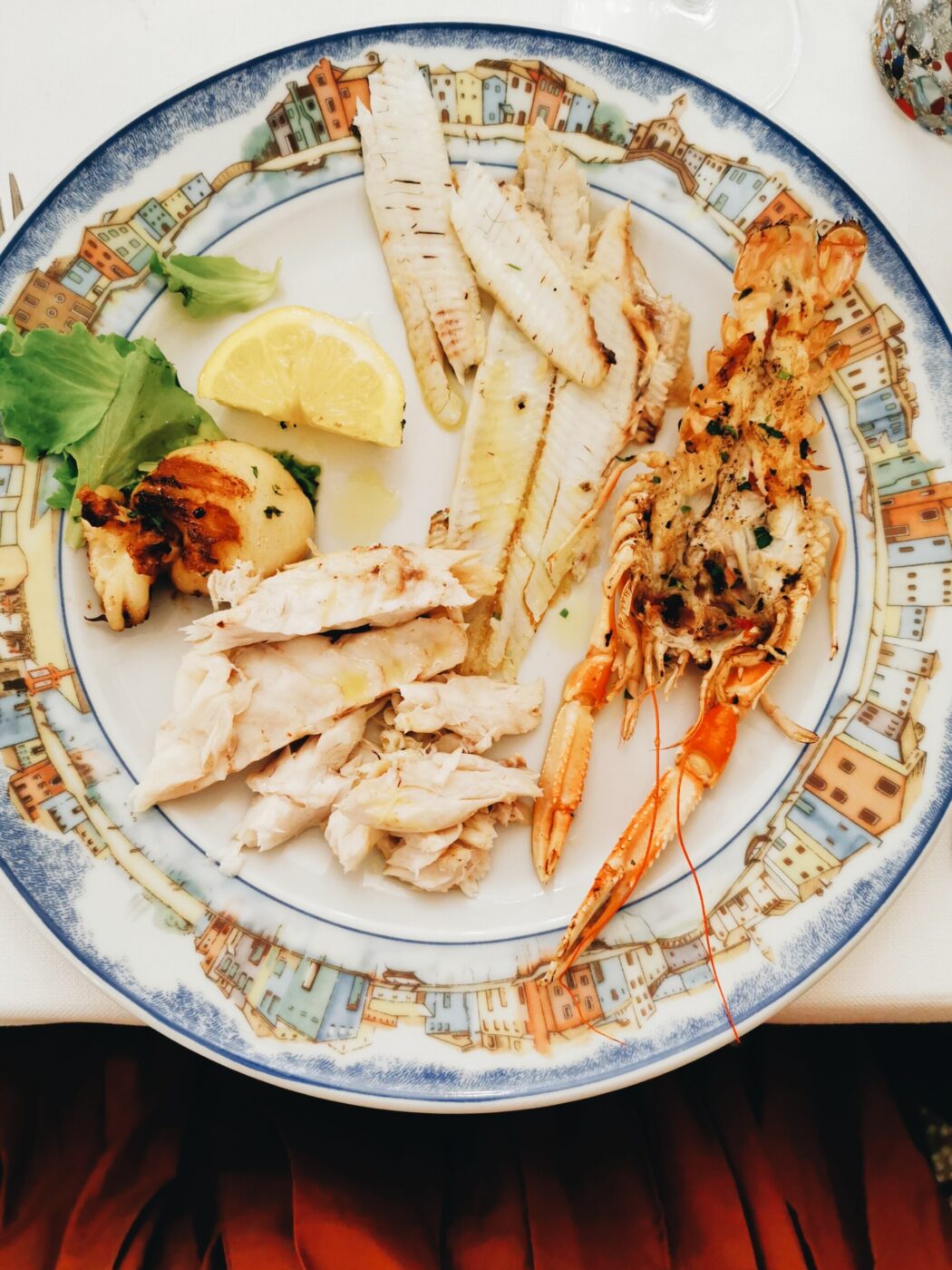Venice is a city that practically defies the laws of physics, a place where roads are water and there’s no real beach front. Once a major maritime hub and still a major stop on any visitor’s route, this northern Italian city has had an array of different cultural influences over the years, resulting in a cuisine that’s just about as irregular as the city itself.
Cicchetti dominate here; tiny dishes served with your afternoon, or morning, ombra (read on to find out what this is), giving you just a little snack–we’d be remiss to compare them to tapas, though if that helps you understand what they are, then there you go. Many of the dishes on this list are considered cicchetti–anything can really become a cicchetti in the right format.
Much of the culinary canon comes from the lagoon on which the city literally sits, and the brackish ecosystem lends an entirely different selection of seafood than the typical Mediterranean fare. Sweet white onions from nearby Chioggia sneak into many dishes, tempering the salinity from the lagoon’s offerings. Aside from seafood, soul-warming staples like polenta are ideal for the winter too, as by now you know our suggestion is to always visit a city in the off season.
Whenever you make it to the floating city, here are 20 foods–and three drinks–you have to try in Venice, with a few recipes to try the iconic dishes at home.
Baccalà Mantecato
Mantecato, meaning creamed, is the most popular preparation of Venice’s baccalà: for this crowd-pleasing appetizer, dried fish is rehydrated and mixed with olive oil, garlic, and other spices until it forms a creamy mousse, best if done with a wooden spoon or mortar and pestle. While the light, fluffy dish is unequivocally Venetian, the namesake baccalà is not. Back in the 15th century–when the city was a major European trade hub–a Venetian ship heading to the North Sea under captain Piero Querini went wayward due to violent storms. Taken in by the locals on Norway’s Lofoten islands, the shipwrecked sailors became infatuated with the local fish–made by long drying and maturing in open air–and brought over 60 with them back to the lagoon. The Venetians named this fish baccalà, after a Latin-derived word for stick, although to the rest of Italy, baccalà means dried, salted cod. (What Venetians call baccalà is what others call stoccafisso, or stockfish–confusing, we know.) In Veneto’s capital, it’s most often served as a cicchetti on top of fried polenta or sliced bread and paired with a glass of white wine; outside of Veneto, you’ll find similar versions made with what they call baccalà. (Find our recipe here!)

Baccalà Mantecato
Sarde in Saor
In saor literally means “in a sour sauce”, and sarde, or sardines, remains the most classic and famous of all saor variants. The not-quite-pickled tradition comes from 1300 AD, when merchant fishermen in the lagoon needed to preserve their fish for long journeys. Soft, lightly caramelized onions and white wine vinegar kept the sardines perfectly fresh and added a much-needed new flavor combo to the otherwise monotonous fish options. It’s easy to make at home (check out our recipe here), but you’ll certainly find the vitamin- and omega-3-packed filets served as a tangy cicchetti at most Venetian bars. Slight variations add in the likes of bay leaves, cinnamon, black pepper, raisins, pine nuts; but the constant across the board is that the sardines only get better with time.

Sarde in Saor; Photo by Manos Chatzikonstantis, Styling by Michail Touros
Tramezzini
For those kids who wouldn’t eat the crusts of your sandwich, or (worse) made your mom cut them off before you would even take a bite, tramezzini are for you: crustless, triangular, white bread sandwiches stuffed with any assortment of fillings–think hard boiled eggs and anchovies, ham and artichokes, asparagus and scampi, tuna and capers–lined up in the windows of every Venetian bar. Mayo is a must, and the more the fillings make the little sandwiches puff up into a half moon in the center, the better. Resembling (and originating from) British tea sandwiches, tramezzini were first made at Turin’s Caffè Mulassano in 1952, though they really grew up and are celebrated in Venice. Here, you’ll snack on them at aperitivo with an ombra of wine, though the word “tramezzini” comes from writer Gabriele D’Annunzio, who derived the term from “tramezzo”, the period between breakfast and lunch. Elsewhere in Italy, you’ll find the triangles tightly wrapped in plastic so they don’t dry out and get crispy edges; but in Venice, the damp humidity from the lagoon keeps them perfectly moist and fluffy.
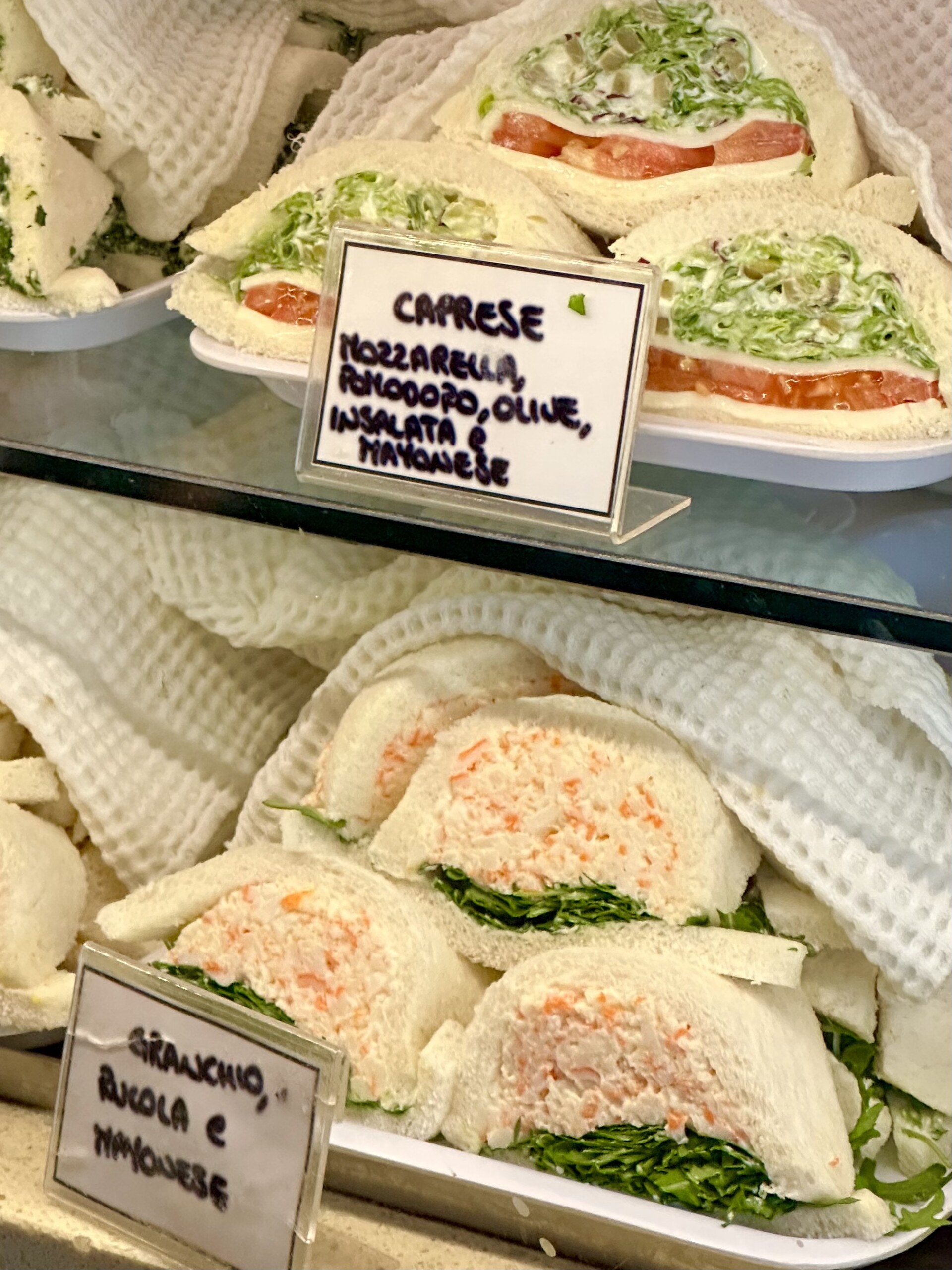
Tramezzini
Sbrisolona
“Big crumbly one” is what this buttery tart’s name translates to, and we could leave the description at that. The base is simply flour and polenta mixed with vanilla, sugar, lemon, butter, an egg, and almonds and/or hazelnuts to form a coarse mixture that gets packed into a baking tin, cooked until crisp, and broken–importantly!–by hand before serving. Though the recipe comes from the 16th century in the city of Mantova (Mantua in English) in neighboring Lombardy, the proximity to Venice means the crumbly tart made its way into the city’s sugary canon. Peasants in Mantova mixed corn flour with lard into a crude form of this cake that eventually made its way into the court of the Gonzaga family, who added spices, nuts, and other high quality ingredients. The giant shortbread is great after dinner with a caffe corretto or, in the morning, dipped into a caffe latte or crumbled and topped with milk to make a sweet cereal. (Check out Italy Segreta contributor Valeria Necchio’s recipe here!)

Sbrisolona
Carpaccio
When you think of the floating mish mash of islands that is Venice, the last thing you’re probably thinking about is cows. Or beef. Or raw beef, for that matter. But you should, for carpaccio as we know and love it was invented right here, in 1950, by none other than Harry’s Bar founder Giuseppe Cipriani–who we can also credit for the invention of the bubbly Bellini. Legend has it that Venetian countess Amalia Nani Mocenigo, a frequent patron of Cipriani’s, was prescribed a strict raw meat diet by her doctor. So Cipriani, inspired by his Piedmontese neighbors, served her a thinly sliced dish of raw tenderloin, topped with a sauce of mayo, mustard, and Worcestershire. It piqued the interest of customers other than Mocenigo, and soon became a menu staple. When it came time to name this colorful dish, Cipriani looked to popular Venetian painter Vittore Carpaccio (1465-1525), whose works were known for vibrant reds, yellows, and whites. We concur that carpaccio, with wonderful versions across Italy and abroad, is quite the masterpiece.

Courtesy of Cipriani
Bigoli in Salsa
Enter bigoli in salsa, better known as Venice’s signature pasta dish. In fact, it’s the only inclusion of pasta in the city’s traditional culinary cannon. Bigoli, or bigoi in local dialect, are long, hearty, thick noodles from Veneto and eastern Lombardy. Traditionally, the strands were made with just flour–often whole wheat or buckwheat–and water, and pushed through a bigolaro, a specialized extruder designed by a Paduan pasta maker in the 1600s. The chewy pasta, similar to Tuscany’s pici, is almost exclusively paired with one specific salsa, or sauce: that of white onions, water, and salted sardines or anchovies. The resulting dish is so umami- and texture-packed that, after one bite, you’ll realize why the Venetians really only needed one pasta dish. Most commonly enjoyed on meatless holidays days such as Christmas Eve, Ash Wednesday, and Good Friday, you can now find bigoli in salsa in most local trattorias, restaurants, and Venetian nonna’s kitchens, who each claim to make the superlative version.

Bigoli in salsa
Risi e Bisi
Risi e bisi, rizi e bizi, rixi e bixi, rice and peas… the dish is pretty much self explanatory (and fun to say) no matter the language or dialect. The rice–which usually is Vialone Nano, a medium-grain variety–is cooked until it reaches a consistency between risotto and soup, and then combined with green peas and pancetta. It’s best in the winter or spring when the peas are freshest and brightest. Though the dish is often mapped to Venice, it actually has origins in neighboring Istria, particularly the Slovenian town of Strunjan. In the past, peas were traditionally cultivated here, and the very best ones were sent to the Duke of Venice. (This left the town of Strunjan with only the rejects and ingredients unfit for the Dukedom, condemning their cuisine to one of “peasant traditions,” but that’s a story for another day.) It’s often associated with April 25th, the Feast Day of St. Mark, when it was offered to the Doge as a sign of good luck. But as long as you have a hearty stock, some butter, and a generous dusting of Parmigiano Reggiano, there’s no need to rely on luck when making this dish.

Risi e Bisi
Crab
This crustacean sure is beloved in Venice. Here, you’ll find it mainly in two forms, either granseola alla veneziana or moeche fritte. The former is a giant spider crab–its tender meat is boiled, cut into thin pieces, mixed with salt, pepper, lemon juice, parsley, and olive oil, before being placed back inside the upside down shell and served. The latter are soft shelled crabs. True foodies know to plan their trip to Venice according to moeche season, lasting a few precious weeks in both the spring and the fall when these crabs shed their shells. Moeche have been harvested and filling the stalls at the Rialto market for nearly 300 years, and The Guardian calls them “a delicacy on a par with the white truffle.” Experts monitor the crabs and, as soon as they start to molt, grab the little pinchers and sell them for upwards of €25 a kilo. The preparation is as morbid as it is delicious: the live crabs are soaked in a seasoned beaten egg mixture for a few hours, which they absorb and eventually drown in. Then, they’re dredged in coarse flour and deep fried before being served, piping hot and golden brown, with sea salt and a squeeze of lemon. The briny, iodine-y, crunchy gems might cost you a pretty penny, but are certainly worth it. Most restaurants offer them, but we love to grab them on-the-go from the market and walk with an ombra. Don’t forget to pour a bit out for the little guys.

Moeche Fritti; Photo by Emiko Davies
Nero di Seppia
If we had to choose one food to eat purely on aesthetics, it would be nero di seppia. Squid ink, or cuttlefish ink, is briny, savory, and umami-like with hints of the sea, but the best part of it is that it dyes whatever you’re eating black. Why settle for plain spaghetti, or normal rice, when it can not only get a boost of salty, sea flavor, but also have it be a fun color? In Venice, the ink is best enjoyed with its producer, cuttlefish, which is braised with aromatics and served atop risotto or spaghetti, both, of course, dyed black. For adventurous cooks, you can try to make it yourself with fresh cuttlefish (inksacks intact) from the market. Though be warned–the ink isn’t very forgiving.

Nero di Seppia
Fegato alla Veneziana
For this simple dish, thinly sliced calf liver is paired with well-caramelized onions–to add a tinge of sweetness–and vinegar, white wine, or lemon juice–to balance out the organ’s earthiness. It’s incredibly tender, best served atop polenta that’s either warm and creamy or grilled and crunchy. The dish has origins in Ancient Rome, when a similar preparation of liver and figs was popular, but the Venetian recipe subbed out the figs with the more readily available onions, which offered a similar sweetness and softness. Even if you’re skeptical of offal, it’s worth a try.

Fegato alla Veneziana
Polenta e Schie
In Italy, there’s a saying that goes: La polenta è utile per quattro cose: serve da minestra, serve da pane, sazia, e scalda le mani. (Polenta is good for four things: to make soup, to make bread, to fill you up, and to warm your hands.) The Venetians sure take this to heart, and eat the corny stuff in about as many forms and dishes as they can think of. Yellow or white, soupy or grilled, polenta is served in Venice with pretty much every entry above this one, but one of the most common preparations is con schie: small Venetian brine shrimp stewed with oil, garlic, salt, and pepper. These tiny gray shrimp come right from the lagoon, and were historically a staple for poor fishermen and other Venetians. The irony is that the shrimp were then overfished and have become somewhat of a delicacy, going for upwards of €40 per kilo at the Rialto market. You can substitute with little pink shrimp, but schie on creamy polenta are a true taste of a Venetian era gone by.
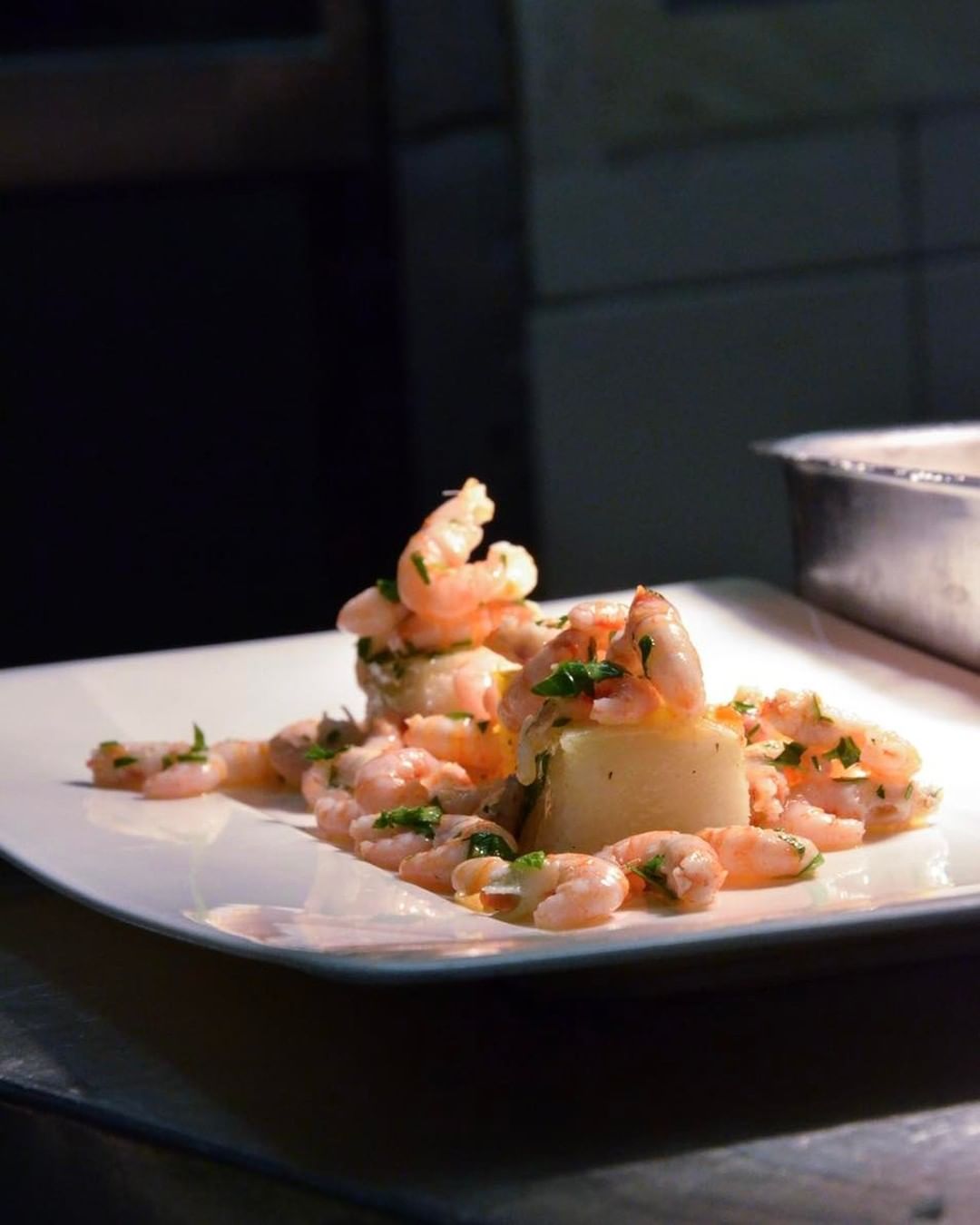
Polenta e Schie; Courtesy of Al Covo
Lo Scartosso (Fritto Misto)
Nothing screams Italian seaside town more than a greasy paper cone overflowing with nearly indistinguishable fried sea creatures. Venice’s version, known as “lo scartosso”, has been around since the 18th century, serving the same golden morsels to hungry passersby. You never know quite what you’re going to get; there’s usually some combination of crabs (moeche if you’re lucky), squid, cuttlefish, shrimp, sardines, mullets, and whiting, accompanied by fried vegetables and onions. It’s up to the season, establishment, and the luck of the serve. But, as long as it’s piping hot and comes with a little squeeze of lemon, it’s gonna be delicious.

Lo Scartosso
Risotto di Gò
The Venetian island of Burano is who we have to thank for this dish, one that proudly defies Italy’s no dairy with seafood rule. But it’s not like the dish could be replicated elsewhere in the country anyway, since it relies on one very specific ingredient: ghiozzi (gò in dialect), the small goby fish of the lagoon. These spiny, kind of ugly, 20-25 cm fish live in the muddy, gucky parts of the lagoon, but boy do the little buggers transform into a wonderfully creamy, pure white, briney risotto. They lend themselves to a flavorful stock that the rice is cooked in, before the risotto is finished in a typical manner: white wine, butter, and lots and lots of Parmigiano Reggiano. A dusting of parsley rounds out the picture, another win from Venice’s cucina povera tradition.

Photo by Emiko Davies
Bisato Su l’Ara
Glass wasn’t the only thing fired up in the ovens on the island of Murano. Back in the day, workers would multitask by slowly cooking their lunch in terracotta pots on the flat stone surface of the furnace, known as the ara. The ingredient of choice? Something the lagoon had plenty of: eels. And so bisato su l’ara was born. The dish is simply cooked eel, seasoned with nothing other than bay leaves and a little salt and pepper, and it was likely served with polenta. Today, it’s harder to recreate this type of slow cooking, and the eels are often cooked in larger pots or in ovens. Since the eel cooks in its own fat, all you really need to recreate it is the spices, a little water, salt, a really hot surface, and some time. Enough time to try your hand at glassblowing, maybe.
Capesante alla Veneziana
Venice has already proven itself when it comes to seafood, but these scallops are the real gold medal winners of the competition. The tender little morsels, which are all too rare in a country that is basically surrounded by the sea, are simply dredged in breadcrumbs, quickly sautéed in olive oil with parsley and garlic, and brightened with a good squeeze of lemon. Best if served on their shell, like Venus in Botticelli’s famed painting. Associated with major holidays like Christmas Eve and New Year’s Eve, these scallops are really love at first sight (aphrodisiac or not).
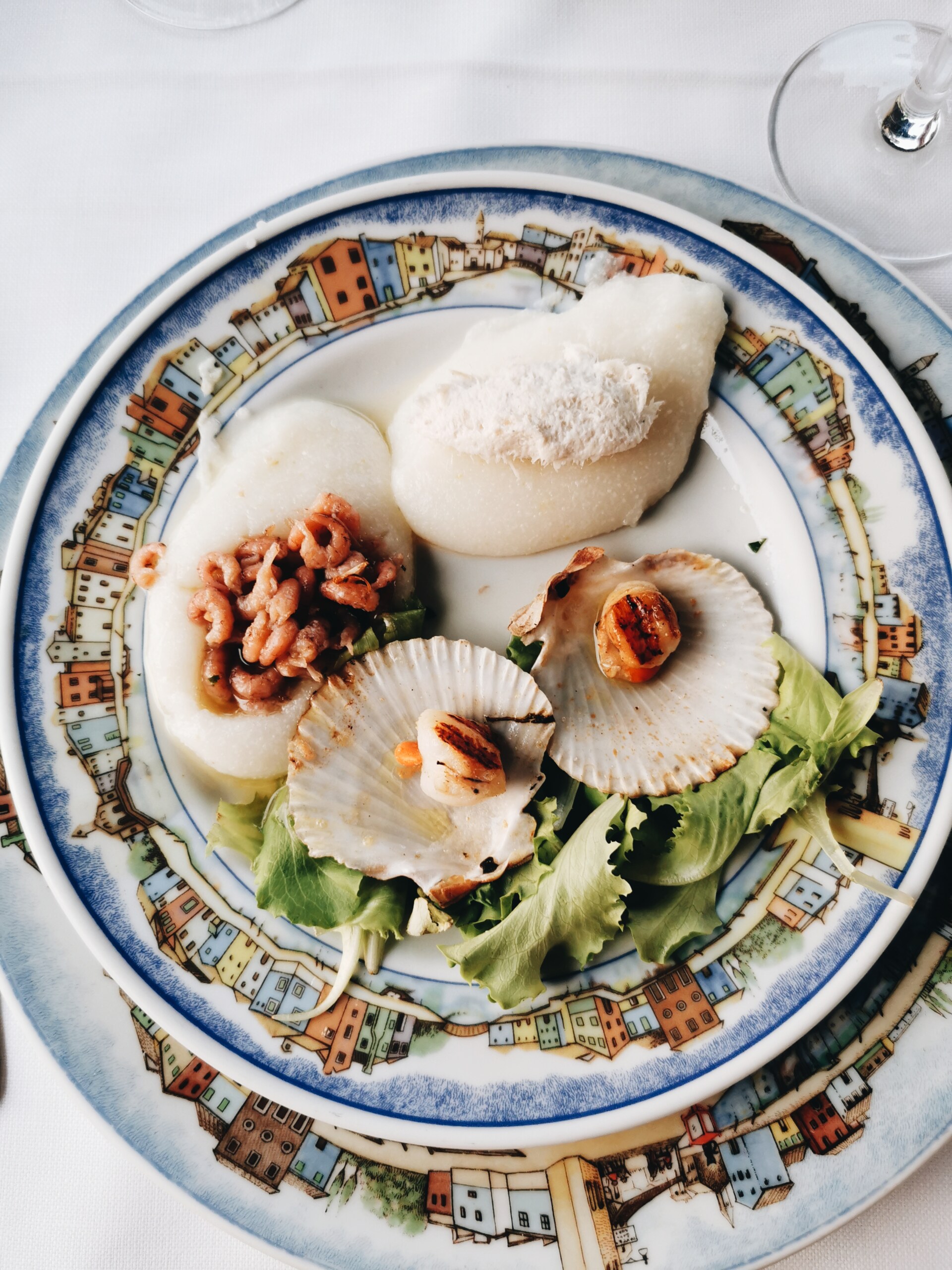
Photo by Emiko Davies
La Castradina
November 21st, better known as the festa della Madonna della Salute, celebrates the Madonna’s merciful end to the terrible plague that struck Venice in the 1600s. Quarantined in their watery city, the Venetians’ only hope of food came from the Dalmations, who gave them salted, smoked, and sun-dried mutton. After the plague ended, the Venetians made mutton the traditional dish of Madonna della Salute as a tribute to those that provided them with food. It takes quite a bit of preparation to make this dish, which includes rounds of pre-boiling, and some recipes say you have to start at least three days in advance. After the final boil of the meat with the usual carrots, celery, and onions, the tender cuts are served with softened cabbage and seasonings. La Castradina doesn’t really resemble anything else you find in Venice, or Veneto for that matter.
Brioche Veneziana
Some say this leavened bread comes from Milan and Lombardy, but we’re here to say that the truth is in the name. This 15th-century foil to the aforementioned city’s panettone, brioche veneziana is made of flour, butter, a leavening agent, and covered with sugar granules and a thin almond icing. Historically, bakers experimented with spices that came through Venice via trade routes. Today, large versions are sometimes studded with candied fruit and perfumed with orange to be eaten around Christmas and New Year’s. Small versions are a popular breakfast choice, particularly if they’re filled with custard.
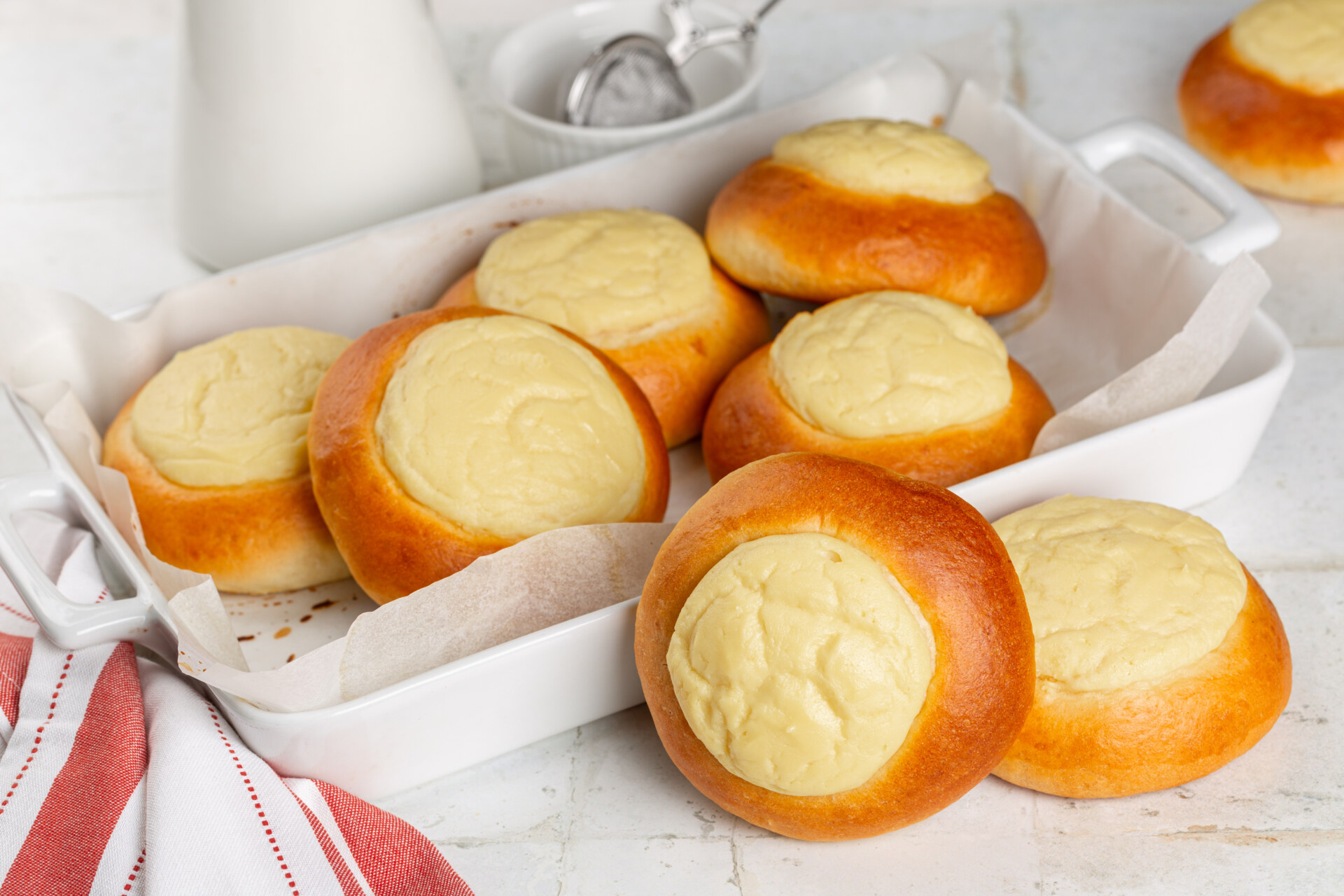
Brioche Veneziana
Crema Fritta
No one does carnevale like Venice. But aside from the masks, the parties, the costumes, and the confetti, there’s two desserts that really make that time of year special. The first, crema fritta veneziana. Literally fried cream, these little heart attacks are made by taking a thick custard, coating it in egg batter and breadcrumbs, and then deep frying it until perfectly crispy. The nuggets are served hot with a generous dusting of sugar. It’s a strangely sweet and savory combo, not to mention a mixture of textures, but the melt-in-your-mouth result quickly dispels any prior skepticism.
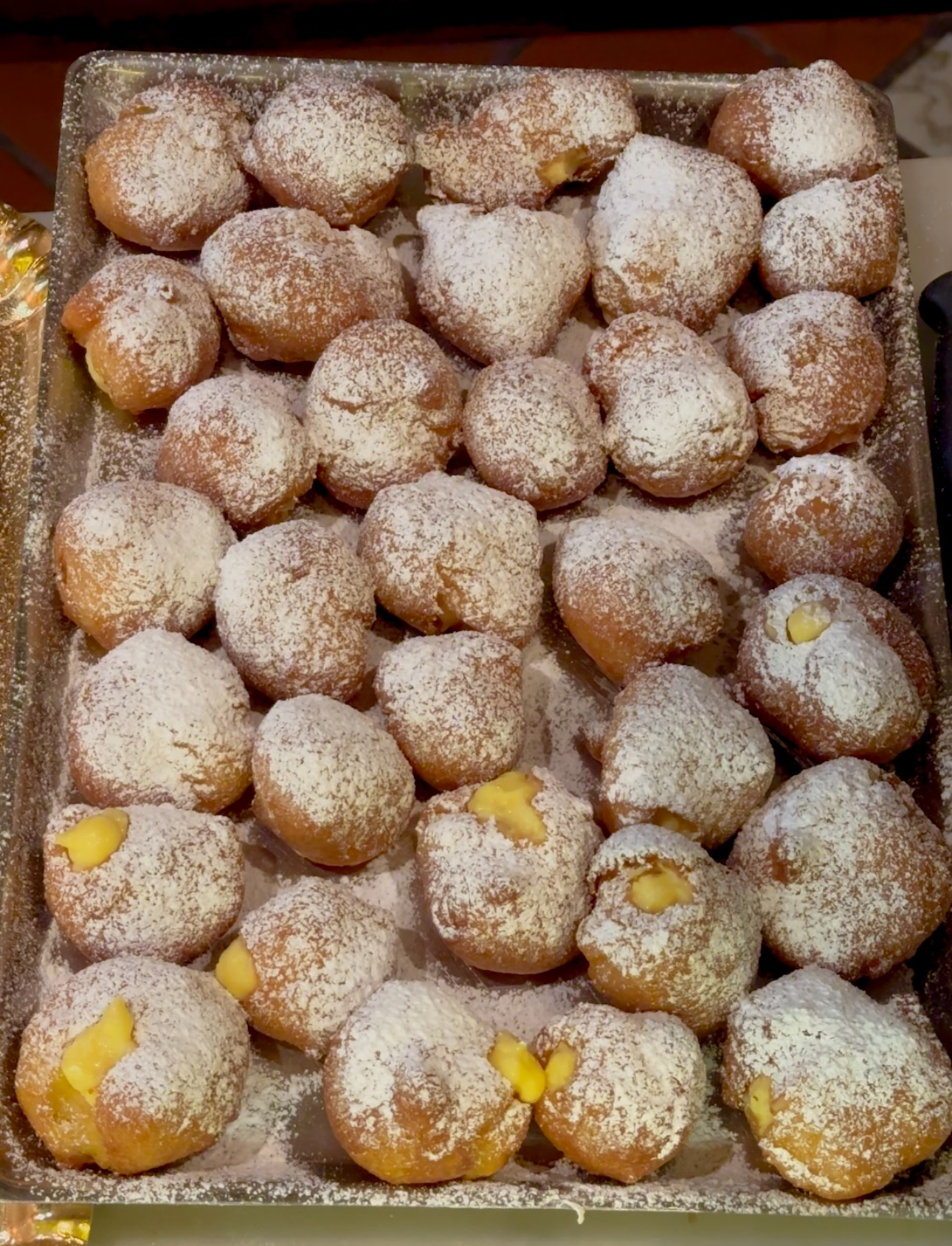
Crema fritta
Fritole alla Veneziana
The second staple carnevale dessert, and one that’s much better for our lactose intolerant friends, is fritole alla veneziana. Made and sold on the streets of Venice since the 1600s, the 1700s saw these fried dough balls elected as the regional sweet of Veneto by the Serenissima Republic. Versions of fritelle exist all across the country, especially come carnevale time, but the Venetian one–according to a recipe preserved in the National Casanatense Library in Rome–is made with eggs, flour, sugar, lemon, and raisins, and covered in more sugar after frying. Indulged in at all hours of the day, it’s best to get these fritole while they’re hot… both literally and figuratively, before they disappear until the next carnevale.
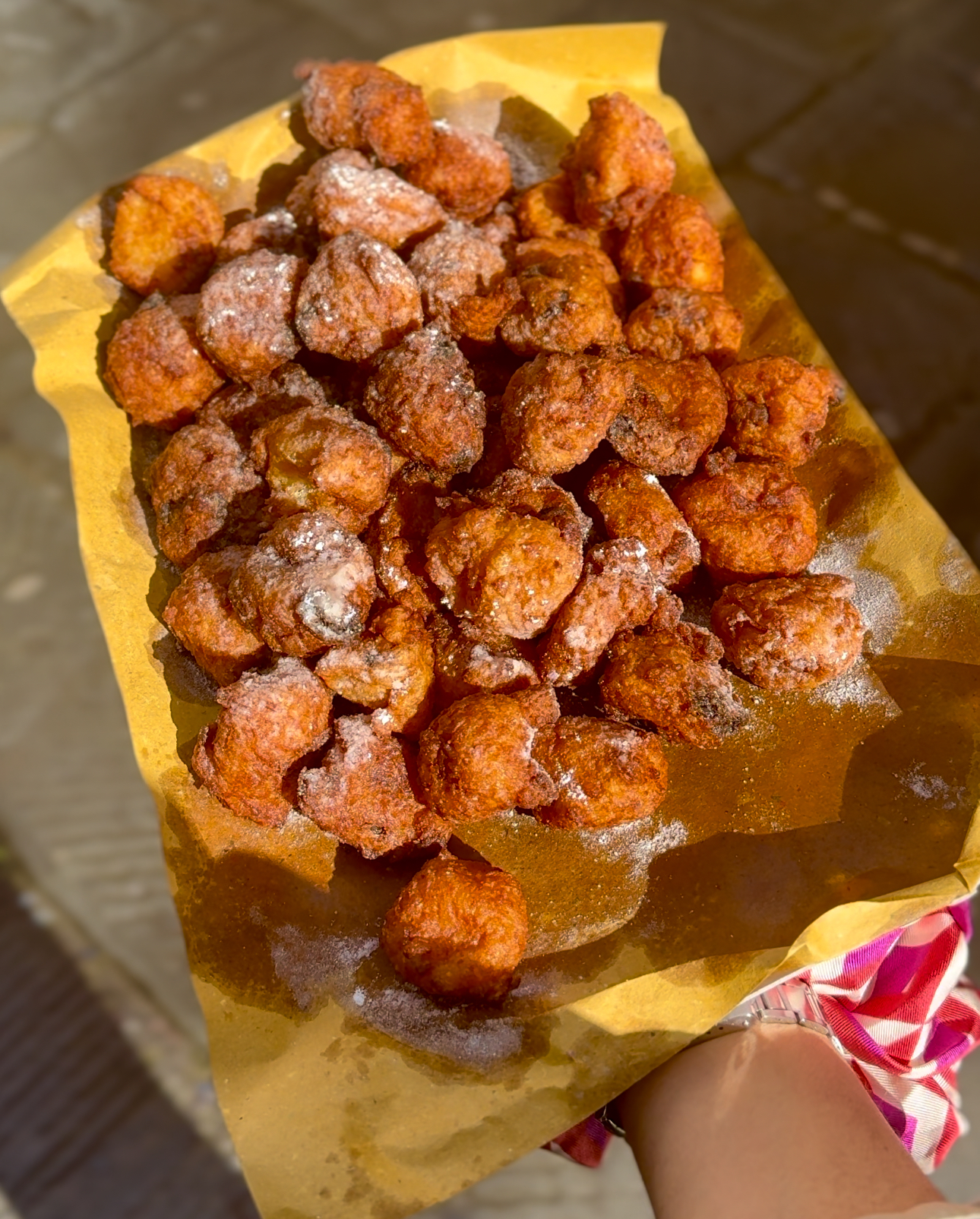
Fritole alla Veneziana
Buranelli & Bussolai
“S” is for “si”, because you’re always going to want to say “yes” to these s-shaped Venetian cookies. Bright yellow thanks to a smattering of butter and egg yolks, the buranelli, bussolai, or essi are Venice’s signature cookies, and they come from the island of Burano. Flavored with vanilla, rum, and lemon zest, they date back to the time of the Venetian Republic, when fishermen’s wives baked batches for their husband’s long voyages. Sometimes bussolai are ring-shaped, named so because “busa” means hole in the Venetian dialect. To make them easier to dip into coffee or sweet wine, legend says a local baker shaped them into an S, and the shape s-s-stuck. If you can’t make it to Burano to try them, they are easy to make at home, and a fitting homemade birthday gift if you have a friend whose name starts with S.
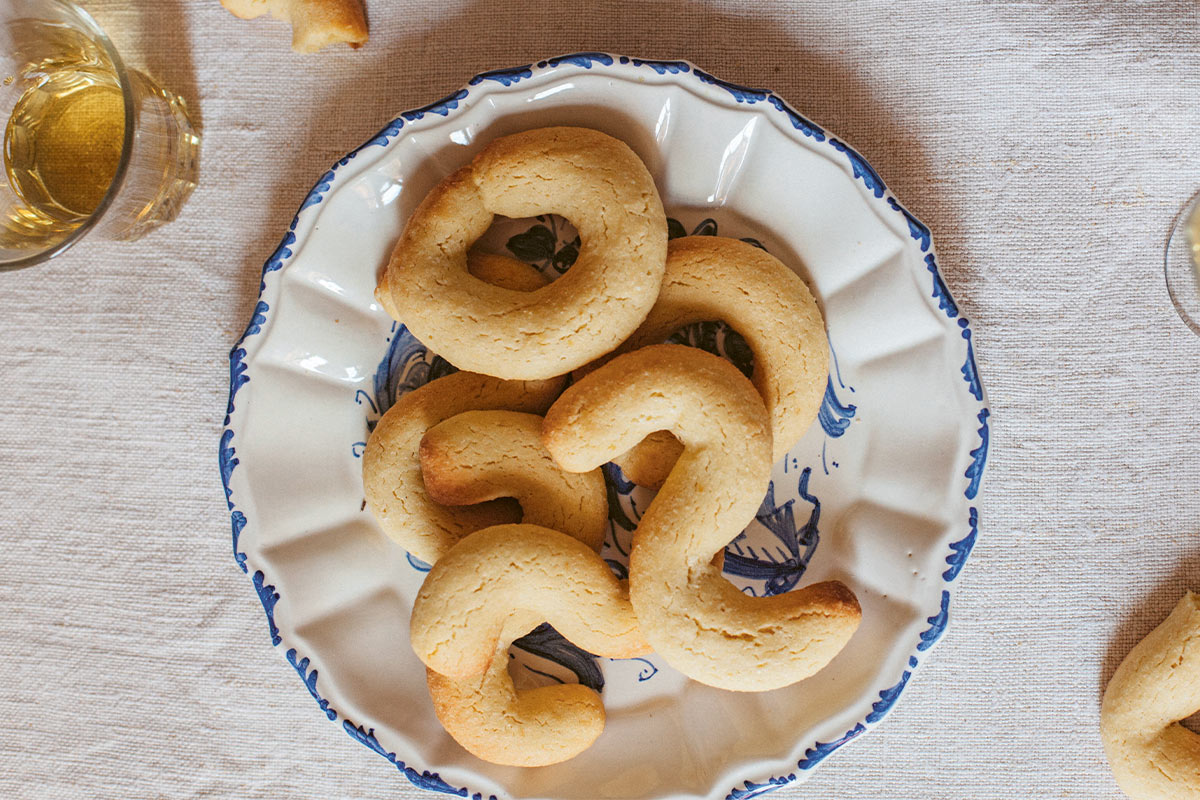
Bussolai; Photo by Emiko Davies
BONUS: Drink up!
In Venice, it’s not uncommon to see glasses of wine appearing as early as 8 or 9 AM; spritzes flow freely by around 11, and aperitivo is in full effect by 3 or 4 in the afternoon. It’s not that the entire city is buzzed; it’s more that they just have some really, really, good cocktails and traditions to their name. Let’s start with the people-pleasing Spritz. Austrian soldiers, who occupied Northern Italy after the fall of the Napoleonic Empire in 1815, weren’t used to the strong flavors and alcohol of Italy’s wines. To pare them down, they began requesting a spray of still water in their wine, or as they called it in German, ‘ein Spritzer. Eventually, this turned into soda water, and at the start of the 20th century, liqueurs and spirits took over from wine. Aperol came about in 1919 thanks to two brothers from Padua, and the rest is an orange, bubbly, and vibrant history.
Moving on to the city’s second concoction, we have the Bellini. This pastel drink is another item on this list we can credit to Harry’s Bar founder Giuseppe Cipriani, who was experimenting with sweet Prosecco and white peach purée when he created this perfect 2-to-1 ratio. And, like with carpaccio, the drink’s pale pink color, which is reminiscent of the hues favored by the Renaissance painter Giovanni Bellini, inspired its name.
Last but not least, we have the ombra. Meaning “shadow”, this drink is what the Venetians call a glass–to be precise, exactly one tenth of a liter–of wine. Legend has it that in St. Mark’s Square, vendors kept their wine cool by staying in the shadow of the bell tower. Over time, the phrase “let’s go have a drink in the shade” evolved into “let’s go get a shade”, and it stuck. Now, if you’re going to get a “shade”, it usually involves a few nibbles of cicchetti, and Venetians have created a whole set of social and culinary rituals around their beloved “shadows”.
